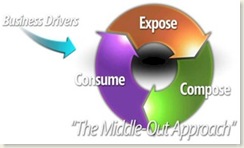People Oriented Architecture - Definition
As I introduced in ‘Virtual Parallels,’ one of the intriguing developments inspiring my examination in ‘Dynamic Work’ is the parallels between increasingly flexible approaches to resourcing both knowledge work and computer work. In the latter realm of systems, the new approaches are often referenced under the rubric of ‘Services Oriented Architecture.’ The key word – ‘Services’ – refers to an approach to developing computer systems that moves away from monolithic programmes designed and built to do one thing or set of things, to an approach that is more based on a ‘federation’ of ‘components’ being assembled to build the capability required.
Many definitions of ‘SOA’ abound. Microsoft has its own resources on the topic that include a handy definition:
“SOA is a standards-based design approach to creating an integrated IT infrastructure capable of rapidly responding to changing business needs. SOA provides the principles and guidance to transform a company's existing array of heterogeneous, distributed, complex and inflexible IT resources into integrated, simplified and highly flexible resources that can be changed and composed to more directly support business goals.”
One could easily hijack that definition for a description of ‘Dynamic Work’
“Dynamic Work is a standards-based design approach to creating an integrated workplace infrastructure capable of rapidly responding to changing business needs. Dynamic Work provides the principles and guidance to transform a company's existing array of heterogeneous, distributed, complex and inflexible organisation and human resources into integrated, simplified and highly flexible resources that can be changed and composed to more directly support business goals.”
